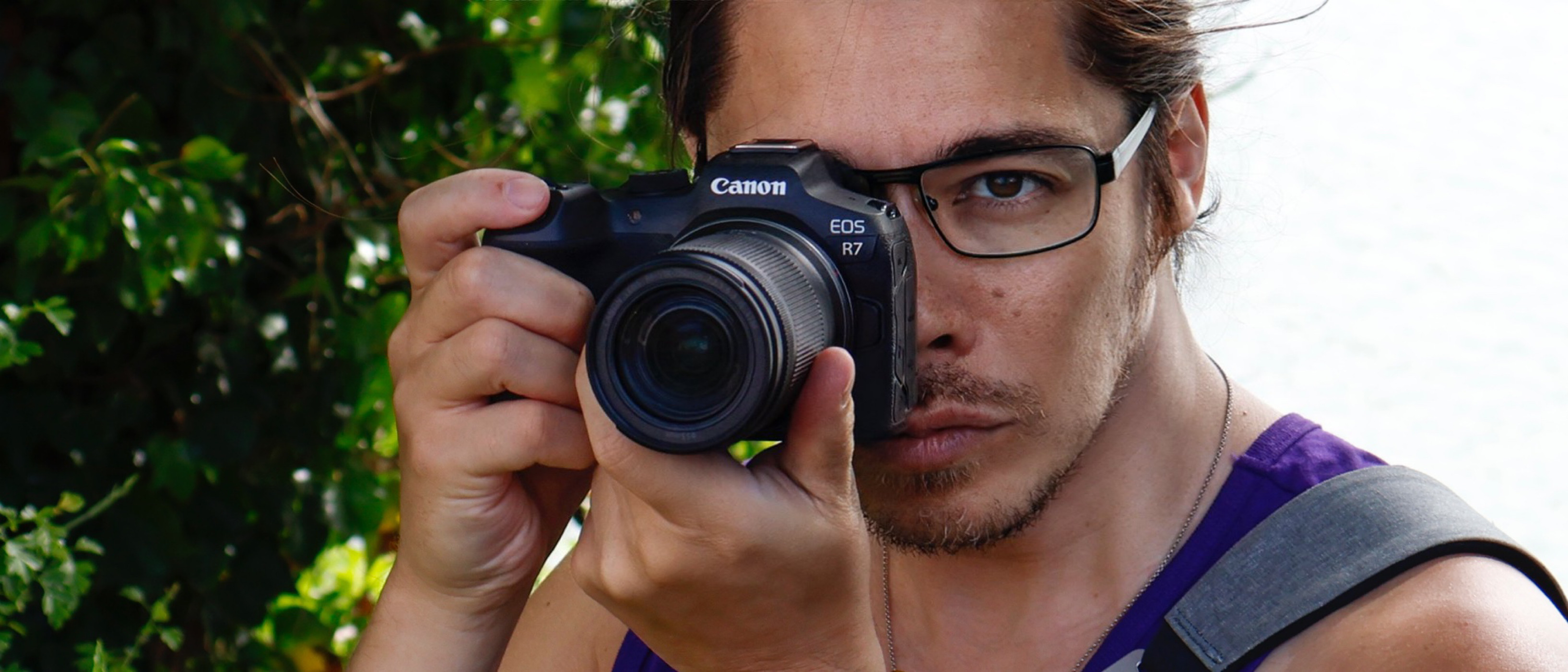Digital Camera World Verdict
The Canon EOS R7 is the first camera you will reach for if you want the advantages of APS-C combined with pro-level speed and AF, with big-time image resolution. It's a fantastic addition to the EOS R ecosystem and a worthy successor to the 90D and 7D lines, making a great proposition for wildlife enthusiasts and anyone who wants to get the most out photography.
Pros
- +
32.5MP resolution
- +
Up to 30fps bursts
- +
7K oversampling
- +
Accepts RF lenses
Cons
- -
Not the biggest buffer
- -
Unusual control wheel
Why you can trust Digital Camera World
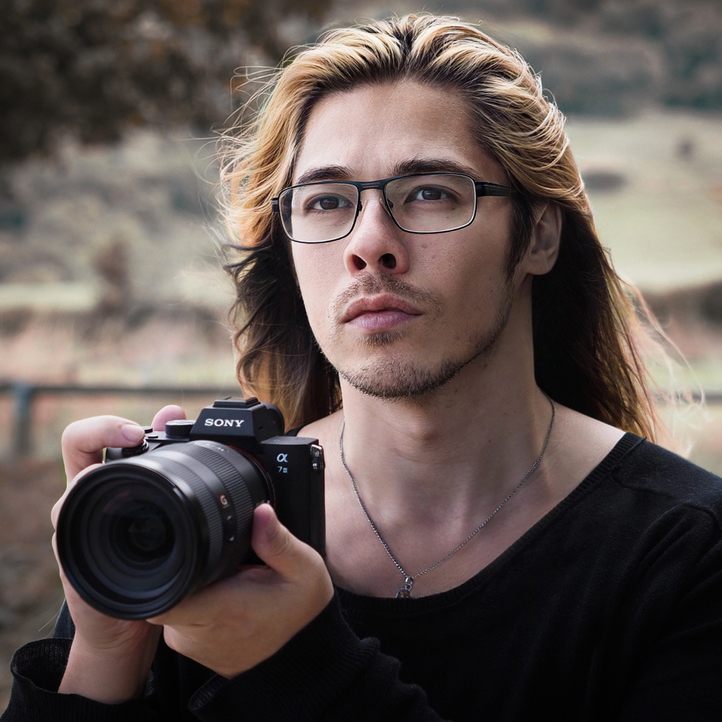
Editor of Digital Camera World, James has 21 years of experience as a journalist and started working in the photographic industry in 2014 (as an assistant to Damian McGillicuddy, who succeeded David Bailey as Principal Photographer for Olympus). This has led him to be a go-to expert for camera and lens reviews, photo and lighting tutorials, as well as industry news, rumors, and analysis for publications like Digital Camera Magazine, PhotoPlus: The Canon Magazine, N-Photo: The Nikon Magazine, Digital Photographer and Professional Imagemaker, as well as hosting workshops and talks at The Photography Show.
The Canon EOS R7 is a camera we’ve been waiting for since the launch of the R system back in 2018. The long-awaited first APS-C member of the EOS R family, it asks questions of the (distinctly much smaller and more compact) EOS M system but gives Canon the most powerful APS-C camera on the market.
Offering speed that matches (and, mechanically, beats) the Canon EOS R3, and resolution second only to the Canon EOS R5, the Canon EOS R7 is a technical marvel. Following in the footsteps of the Canon EOS 90D and Canon EOS 7D Mark II, shooters will leverage its 1.6x crop factor to amplify the effective focal length of full frame lenses.
As such, this could become the best camera for wildlife photography thanks to its unique combination of resolution, crop factor and sheer speed.
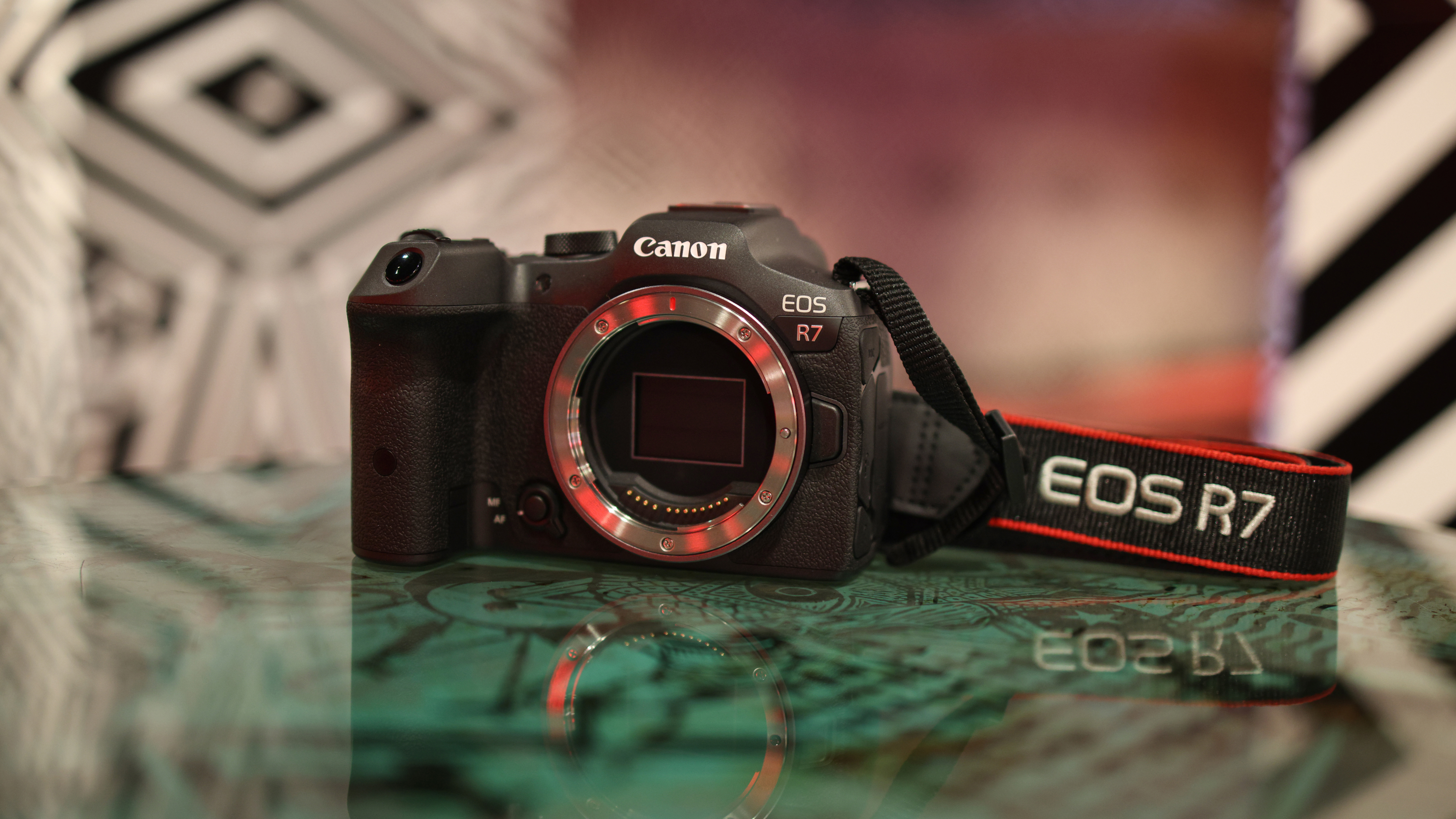
Canon EOS R7: Specifications
Sensor: 32.5MP APS-C
Image processor: Digic X
Mount: Canon RF
Autofocus: Dual Pixel CMOS AF II, 5915 AF stills positions / 4823 movie positions
ISO range: 100 to 32,000 (exp to 51,200)
Image stabilization: 5-axis IBIS, up to 8 stops (lens dependent)
Max image size: 6.960 x 4,640
Max video resolution: 4K 60p, 4K 30p (oversampled 7K), 1080p 120p
Viewfinder: 2.36m dot, 120fps
Memory cards: 2 x SD/SDHC/SDXC, UHS-II
LCD: Articulating touchscreen, 1.62m dots
Max burst: 30fps electronic, 15fps mechanical
Connectivity: Wi-Fi 2.4Ghz, Bluetooth, USB-C, headphone jack, microphone jack
Size: 132 x 90.4 x 91.7mm
Weight: 612g (with battery and memory cards)
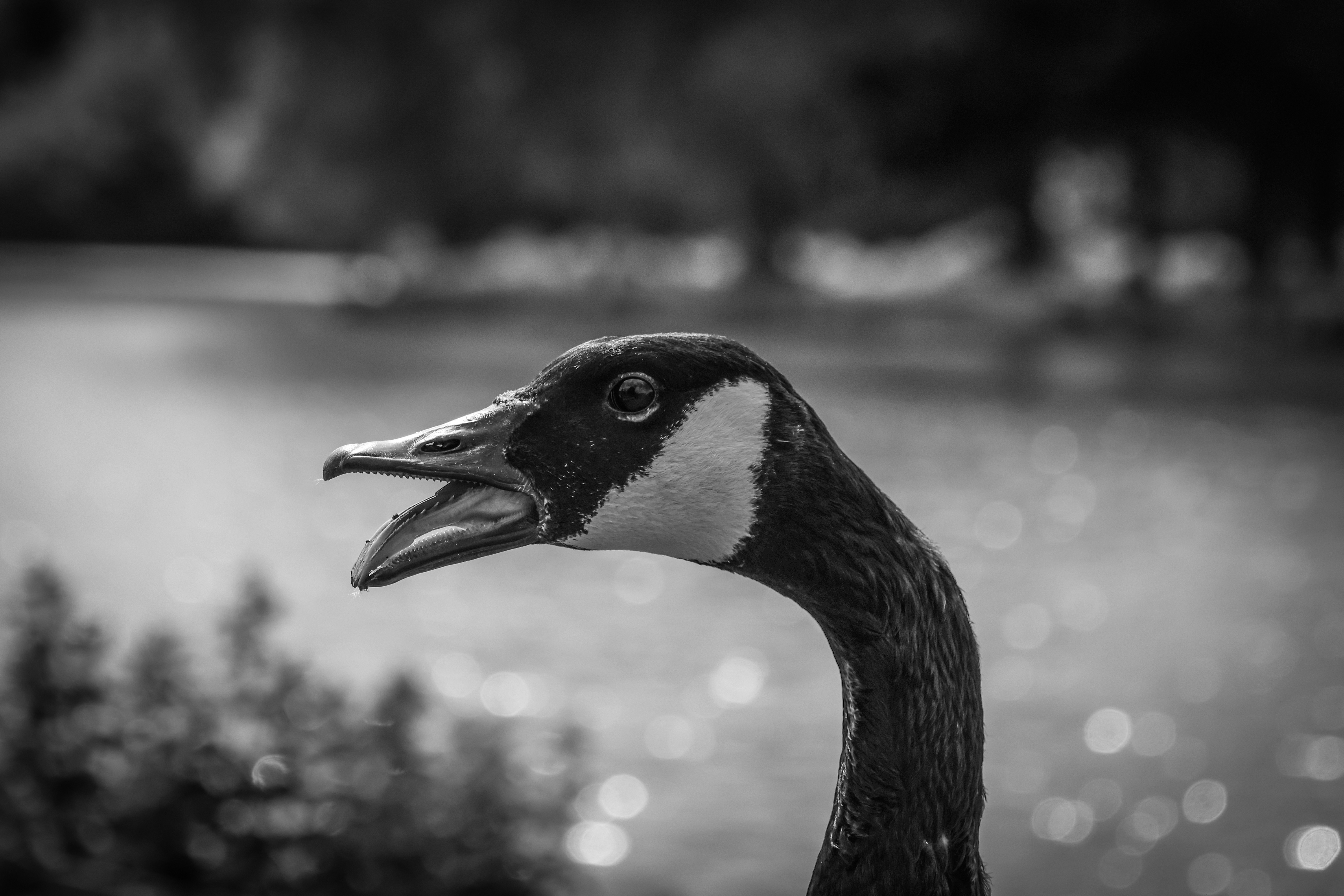
Canon EOS R7: Key features
The R7 is built around a 32.5MP APS-C sensor, which packs more resolution than any cropped sensor camera on the market other than the Fujifilm X-T5 and Fujifilm X-H2 – which is something that will come as music to the ears of wildlife photographers and birders, always keen for more freedom to crop in.
While it’s not a completely new sensor (being built on the same architecture as the 32.5MP sensor in the 90D and Canon EOS M6 Mark II), it features optimized wiring layer and microlens technology to deliver improved signal readout.
It also features staggering shooting speeds of 15 frames per second mechanically – faster than any other Canon EOS camera, including the R3, R5 and R6 – and 30 frames per second electronically – which matches the R3, Sony A1 and Nikon Z8/Z9 (unless you factor in the latter’s 11MP crop mode).
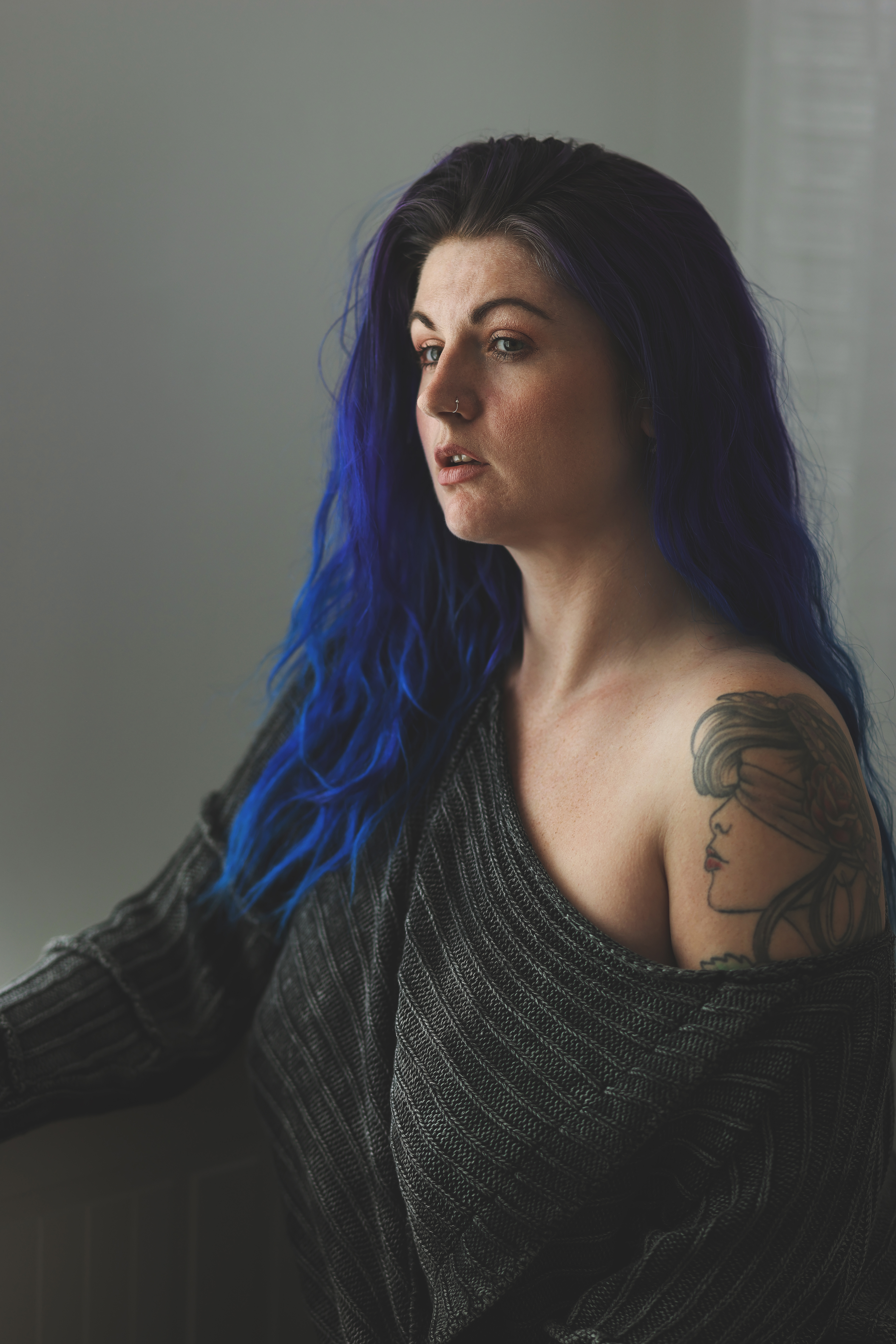
This is Canon’s first ever APS-C camera to feature in-body image stabilization – a 5-axis system that delivers up to 8 stops of compensation, depending on the lens (it offers 7 stops, for example, on the new Canon RF-S 18-150mm f/3.5-6.3 IS STM).
It also boasts the R system’s newest, most sophisticated autofocus developments: Dual Pixel CMOS AF II, with human, animal and vehicle subject recognition, case studies, and AF acquisition down to -5EV.
In terms of video the R7 is quite the powerhouse, capable of uncropped 4K 60p, 4K 30p oversampled from 7K, and 1080p up to 120p – and Canon tells us that you can record around 60 minutes of video before overheating and record limits come into play. The camera features Canon Log-3, clean HDMI out, as well as a microphone input and headphone jack.
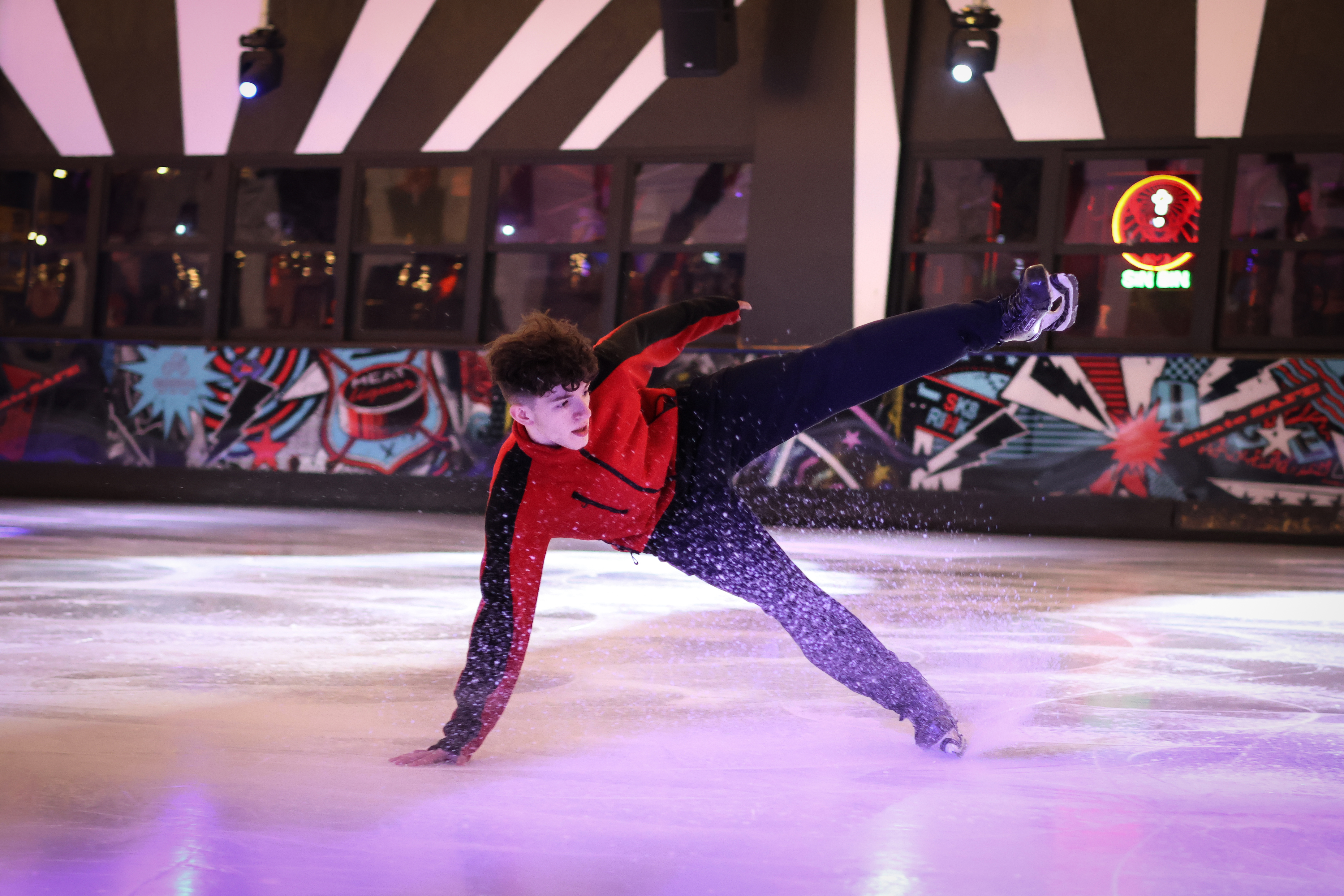
Canon EOS R7: Build and handling
The R7 is smaller and lighter than the 90D, offering a compact chassis that’s still somehow reassuringly chunky thanks to its thick grip. It also features the same weather sealing as the 90D, along with dual UHS-II SD memory card slots.
Perhaps more than any other R system camera, it feels most like the EF body it’s replacing when held and used, with the familiar grammar of the EOS menu system making this feel like an old friend – and a natural way to graduate from a Canon DSLR.
Something that’s going to take a little getting used to is the new arrangement of joystick and control wheel – the latter of which has moved from its familiar position to the lower-right of the camera rear, and now encircles the joystick at the top next to the EVF.
The control wheel is smaller and more delicate than on other EOS bodies, and may threaten to feel a bit fiddly if you have large thumbs. You’ll also need to adjust your muscle memory if you’re used to spinning the wheel to adjust settings mid-shoot.
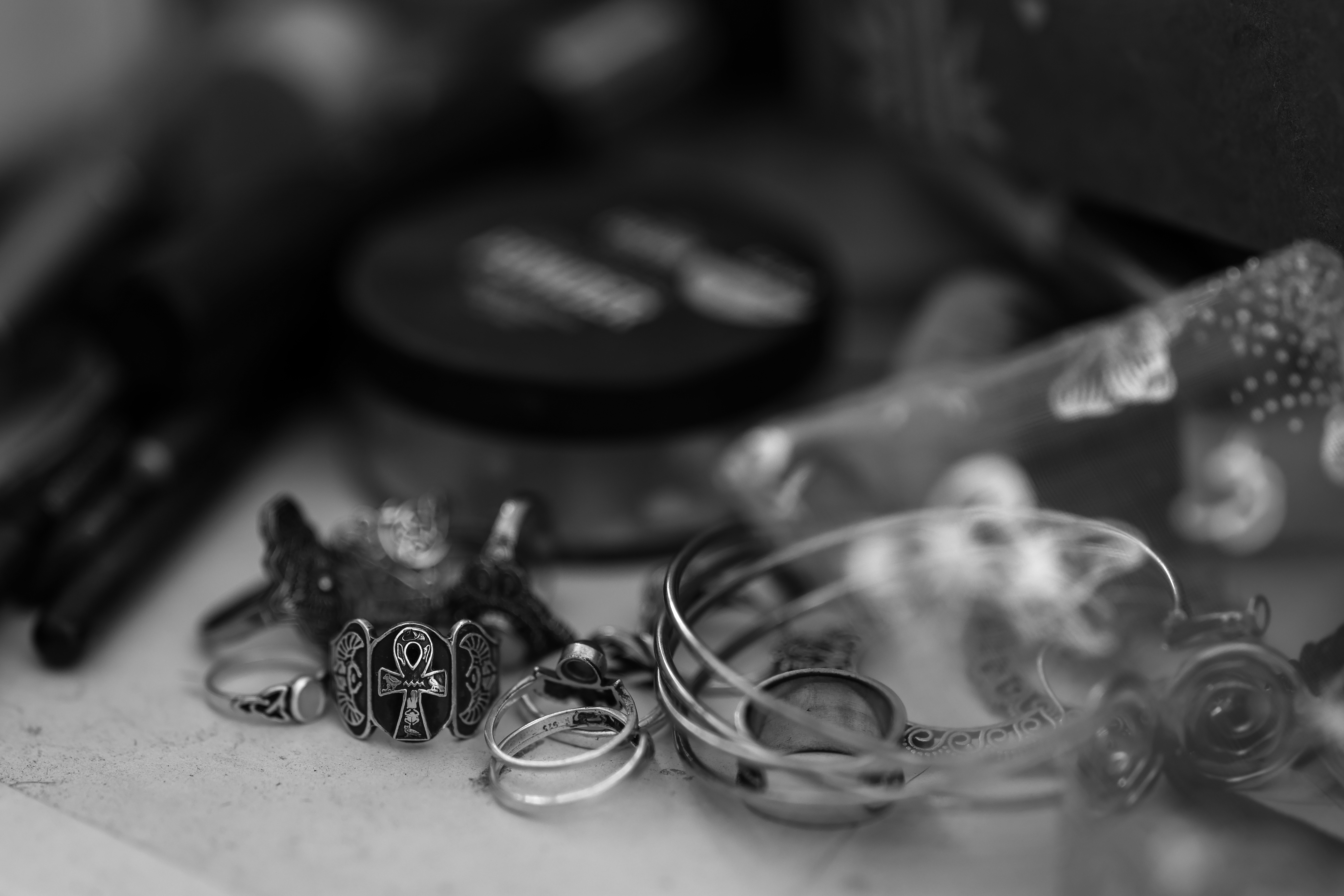
Once your hands are used to the new layout, though, it actually feels logical and sensible to have the wheel and the joystick in the same place – and it’s a very efficient way to maximize space on the smaller body.
Obviously the body is smaller thanks to the smaller sensor. And to accommodate the smaller sensor, Canon has introduced a new line of lenses with the APS-C format in mind: RF-S lenses (taking their name from the EF-S standard, which was the APS-C version of EF-mount glass).
The reduced sensor size and throw of the APS-C format means that smaller, lighter lenses – such as the new Canon RF-S 18-45mm f/4.5-6.3 IS STM – can be mounted on the system. However, the Canon EOS R7 uses the same RF mount as its full frame counterparts – which means that existing full frame RF lenses can be used natively, while EF and EF-S lenses can also be used via the Mount Adapter EF-EOS R.
Do note, however, that EF-M lenses (APS-C optics designed for Canon’s other APS-C line, the EOS M system), will not work with the R7, despite them sharing the same sensor format.
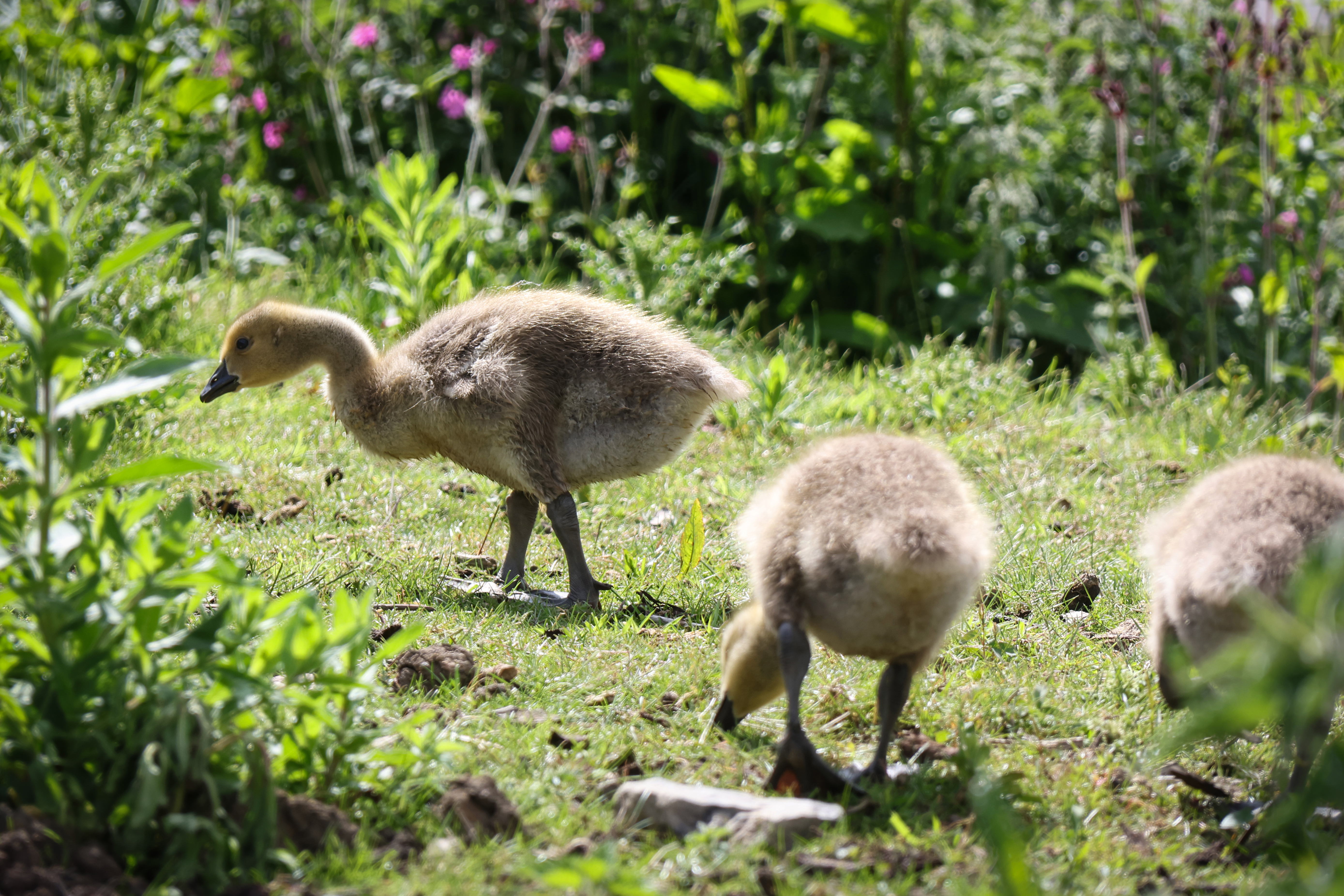
Canon EOS R7: Performance
In a lot of ways, shooting with the R7 really does feel like shooting with a mirrorless (read: sleeker and smaller) 90D – but with way more bells and whistles.
The camera really feels tailor made for the RF-S 18-150mm lens (or, rather, the lens for it), and the pair make a formidable combination for run-and-gun, travel and everyday photography – and even videography. This is a great tandem for all-purpose shooting and content creation.
However, if you want to get serious, the R7 has the speed and resolution to make the most of premium full frame glass like the Canon RF 85mm f/1.8L USM. Certainly the bigger L-series glass is oversized for the svelte APS-C body, but you really can't fault the results.
Where this camera really comes into its own is in its amplification of focal lengths, and how this benefits wildlife shooters. Mount the Canon RF 800mm f/11 on this and you've got an effective 1280mm lens with 32MP of resolution to crop in further – all powered by killer Animal AF.
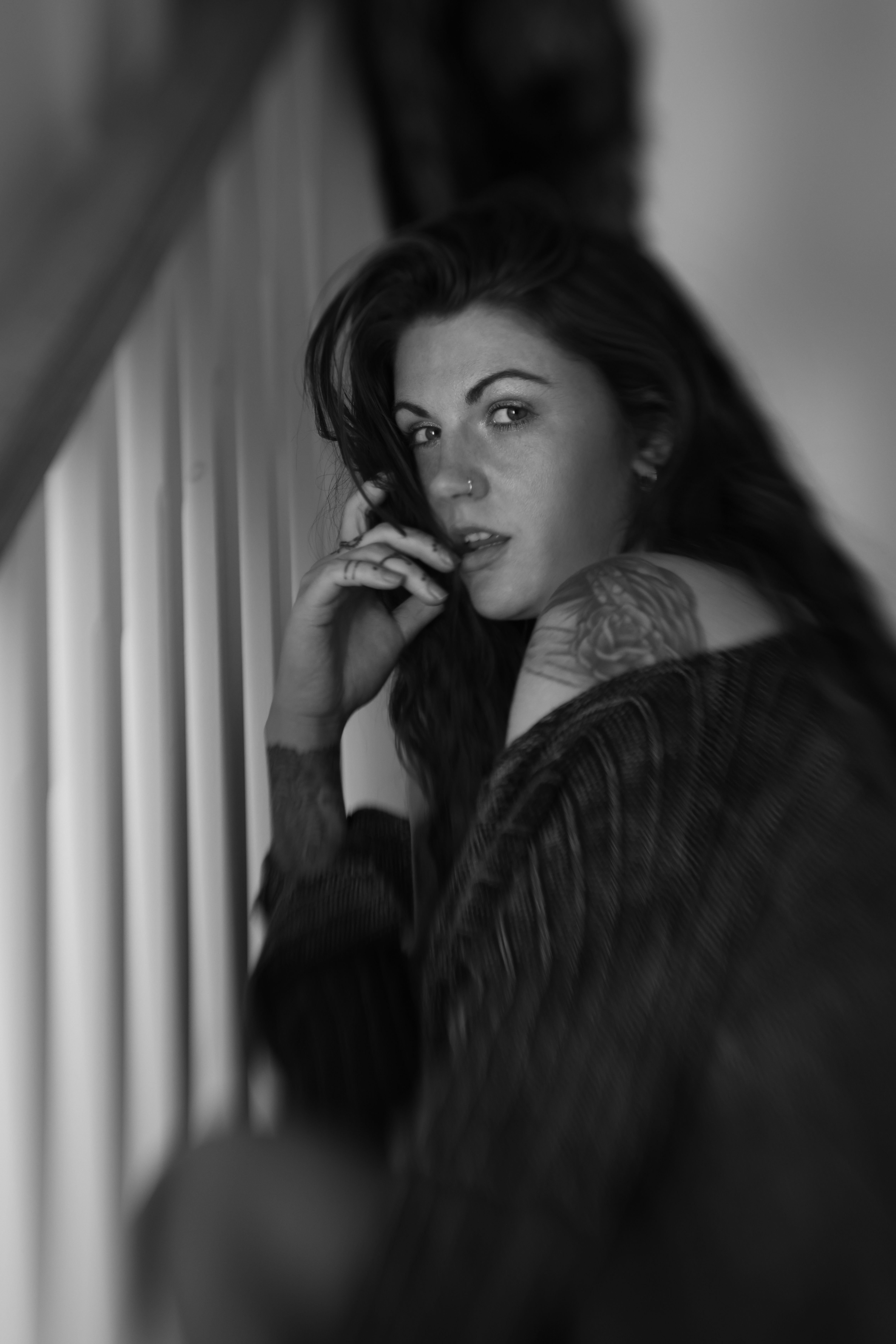
The subject detection and tracking are, as you would expect of the brilliant Dual Pixel AF II technology, superb. We shot a range of subjects, from fast-moving ice skaters to static models to a variety of waterfowl, and the autofocus never let us down.
It was sticky and adaptive when flitting between eye, head and body detection while shooting skaters doing tricks, and incredibly instinctive when shooting all manner of birds waddling and swimming erratically through the frame. The AF also performs brilliantly when shooting video, not even being fooled by subjects disappearing behind foreground obstructions.
While it possesses lightning-fast shooting speeds, the buffer is limited by the choice of SD cards over CFexpress, with maximum bursts hitting 46 RAWs and 184 JPGs. But that's still enough to get controlled salvos of shots, and we didn't miss anything we were aiming for.
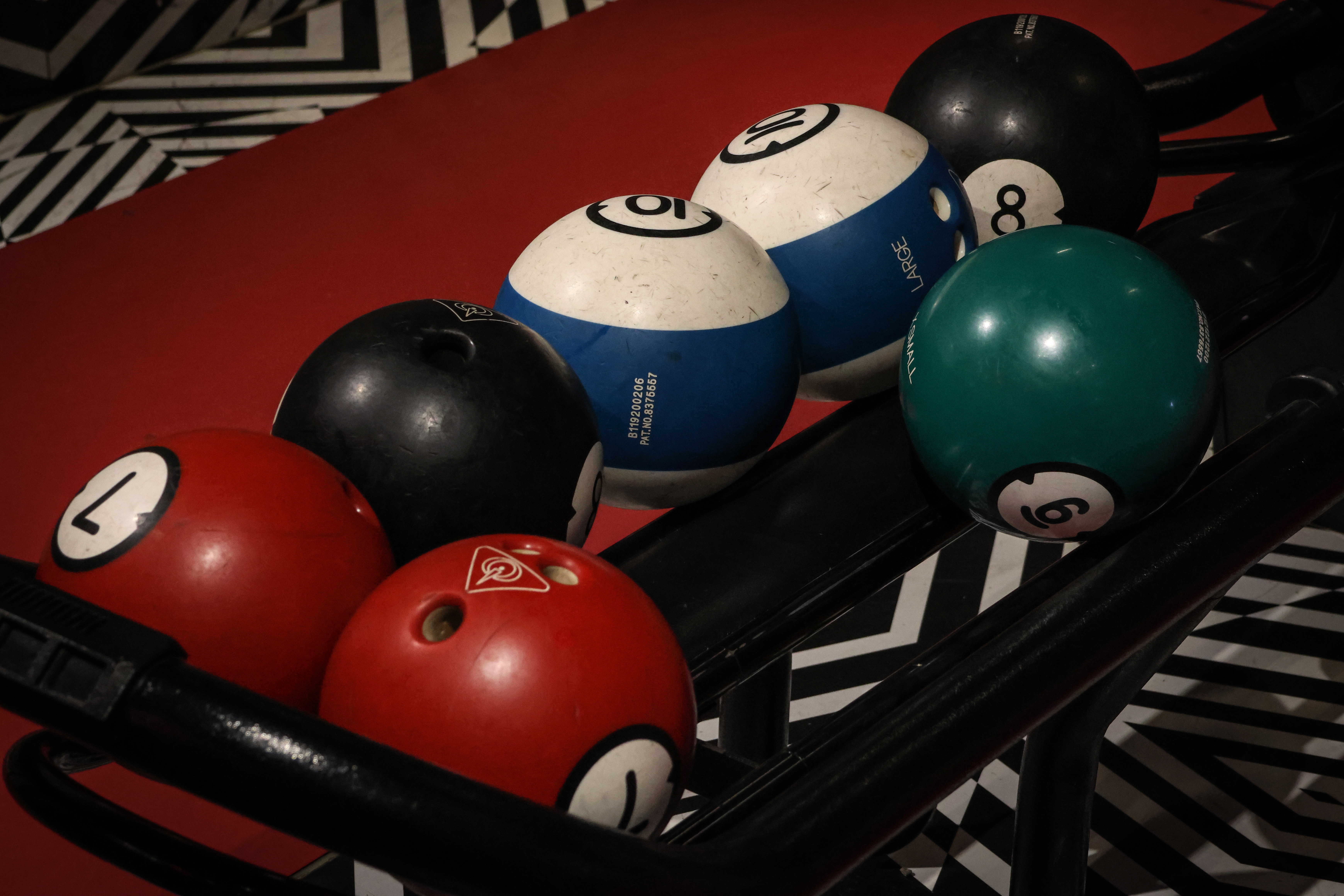
Canon EOS R7: Lab results
For our lab data comparison, we compared the EOS R7 to its flagship rival APS-C mirrorless cameras from Fujifilm and Sony: the X-T4 and a6600. Nikon's best APS-C offering is the Z50, but this is a closer rival to the EOS R10. We instead opted to include the Nikon Z5, as despite being full-frame, it costs about the same as the R7, making it an intriguing alternative.
We test resolution using Imatest charts and software, and dynamic range and signal to noise ratio with DxO Analyzer.
Resolution:
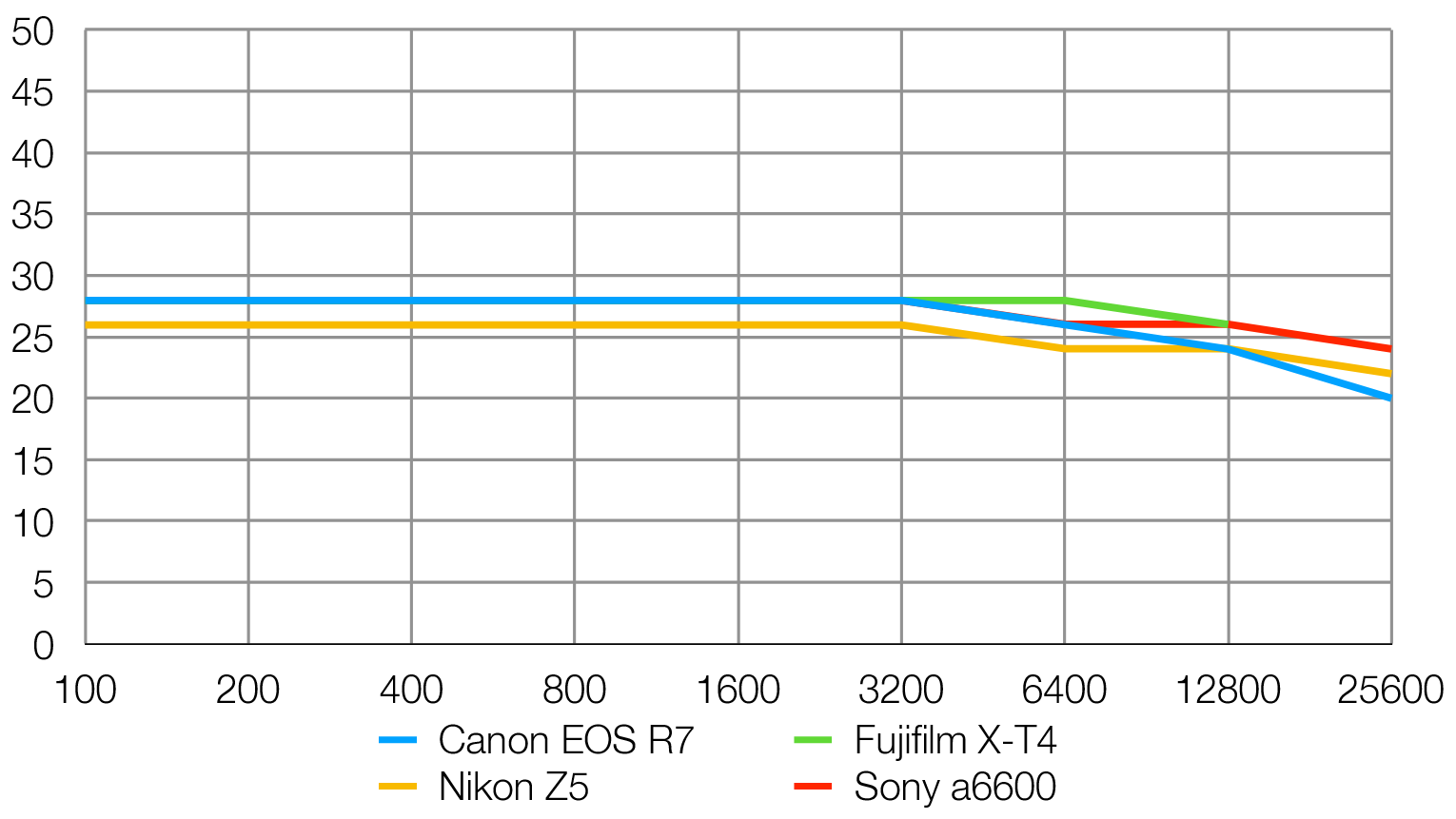
Despite its 32.5MP sensor being the most pixel-packed here, the R7 only ties with the 26.1MP X-T4 and 24.2MP a6600 when it comes to resolving fine detail. At really high sensitivities, the Canon even falls slightly behind the competition, due to high ISO image noise obscuring fine detail.
Dynamic range:

Dynamic range at lower sensitivities is excellent, on par with the X-T4 and the full-frame. However at ISO 800 and above, the R7 struggles to capture as much dynamic range as its rivals.
Signal to noise ratio:

This test compares the amount of random noise generated by the camera at different ISO settings as a proportion of the actual image information (the 'signal'). Higher values are better and we expect to see the signal to ratio fall as the ISO is increased.
Compared to the Z5 and X-T4, the R7's images display more image noise at mid and high ISO sensitivities. The noise itself doesn't look particularly ugly or distracting to the naked eye though, so take this result with a pinch of salt.... or grain!
Canon EOS R7: Verdict
All things considered, we're very impressed with what the Canon EOS R7 can do. It's lightning fast both mechanically and electronically, the resolution offers glorious detail as well as the opportunity to crop into your wildlife shots, and the 1.6x crop factor makes your lenses even longer for shooting faraway subjects.
There's plenty of play in the files, giving you lots of leeway for post production, and the video quality is crisp and clear in both 4K and 1080p, with autofocus performance that won't let you down.
Lab results aren't quiet a clean sweep for the Canon, but the real-world differences will be subtle – we don't think this is even close to a deal-breaker when you factor in everything else the camera has to offer. Quite simply, the R7 is the new king of APS-C mirrorless cameras.
You might also be interested in the best Canon cameras, and you can see how they compare to the best mirrorless cameras from all brands. We also recommend checking out the best Canon RF lenses for the EOS R system.

James has 22 years experience as a journalist, serving as editor of Digital Camera World for 6 of them. He started working in the photography industry in 2014, product testing and shooting ad campaigns for Olympus, as well as clients like Aston Martin Racing, Elinchrom and L'Oréal. An Olympus / OM System, Canon and Hasselblad shooter, he has a wealth of knowledge on cameras of all makes – and he loves instant cameras, too.

